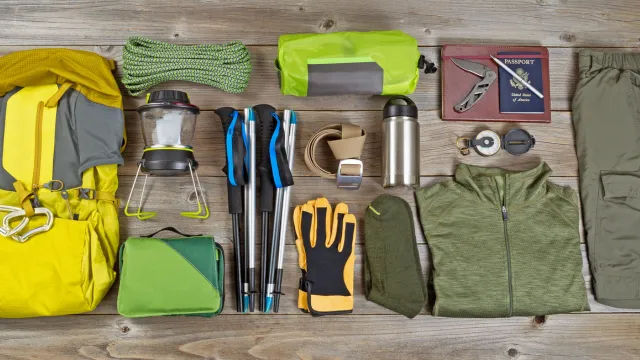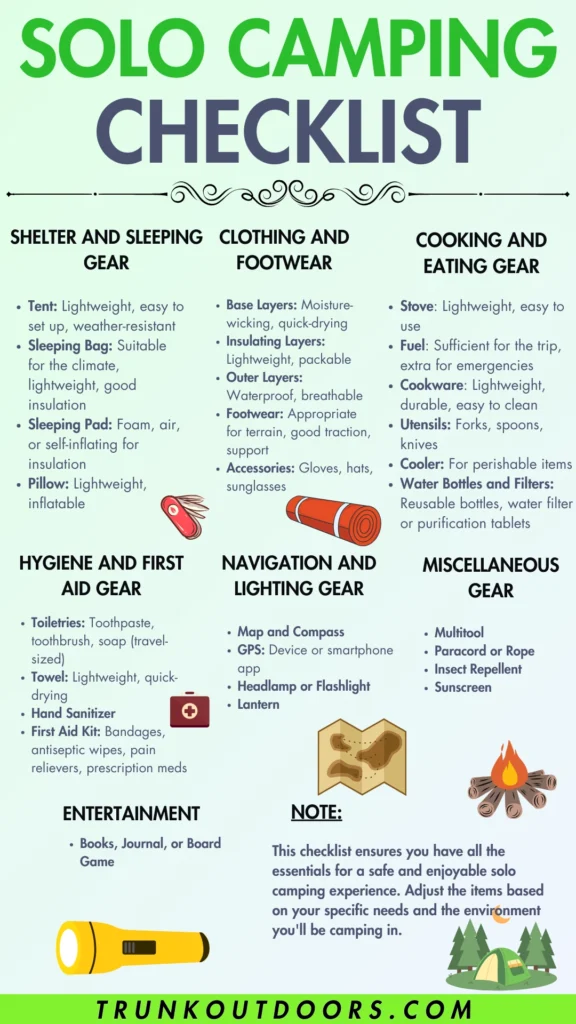Solo Camping Checklist: Comprehensive Guide ( Free Printable)
Solo camping can be a very rewarding experience. The freedom to choose your own adventure, the opportunity to disconnect from the world, and the chance to spend quality time in nature can be both rejuvenating and empowering.
But before you head out on your solo adventure, it’s important to make sure you have all the gear you need to stay safe and comfortable.
In this article, we’ll provide you with a comprehensive solo camping gear checklist, covering everything from shelter and sleeping to cooking and hygiene.
Related: 7 Essential Solo Winter Camping Tips for a Safe and Enjoyable Trip

1. Shelter and Sleeping Gear
- Tent
The first item on your solo camping gear checklist should be a tent. It will be your home away from home, and it’s essential to choose a reliable and sturdy one.
When selecting a tent, consider that easy to set up and take down, its lightweight, and its weather-resistant features. You don’t want to get caught in a storm with a leaky tent!
- Sleeping Bag
A high-quality sleeping bag is another crucial item on your solo camping gear checklist. It’s essential to choose a sleeping bag that is appropriate for the climate you will be camping in.
You should also consider the size and weight of the sleeping bag (lightweight and easy to pack), as well as its insulation material.
- Sleeping Pad
A sleeping pad is another important item for a good night’s sleep that should be on your solo camping gear checklist.
A sleeping pad provides a layer of insulation between you and the ground, which is essential for staying warm and comfortable.
There are many different types of sleeping pads available, including foam pads, air pads, and self-inflating pads.
Consider your personal preferences, the type of camping you’ll be doing and the quality of insulation from the ground, when choosing a sleeping pad.
- Pillow: Although a pillow might seem like a luxury item, it can make a big difference in how well you sleep. Look for a lightweight, inflatable pillow that packs down small.
2. Clothing and Footwear
- Base Layers: Base layers are the foundation of your clothing system. Choose base layers that are moisture-wicking and quick-drying to keep you comfortable.
- Insulating Layers: Insulating layers help to trap your body heat and keep you warm. Choose insulating layers that are lightweight and easy to pack.
- Outer Layers: Choose outer layers that are waterproof and breathable, that conserve you from wind, snow, and rain.
- Footwear: Having the right footwear is essential when camping. Choose shoes or boots that are appropriate for the terrain you’ll be camping on that provide good traction and support. If you’ll be hiking, choose shoes or boots with good traction and ankle support. If you’ll be camping near water, consider waterproof footwear.
- Accessories: Don’t forget to pack accessories like gloves, hats, and sunglasses to protect you from the sun, wind, and cold.
3. Cooking and Eating Gear
- Stove: A stove is essential for cooking your meals. Choose a stove that is lightweight and easy to use.
- Fuel: Make sure you have enough fuel to last for the duration of your camping trip. Consider bringing extra fuel in case of emergency.
- Cookware: Choose cookware that is lightweight and easy to pack. Look for cookware that is durable and easy to clean.
- Utensils: Don’t forget to pack utensils like forks, spoons, and knives. Look for utensils that are lightweight and easy to pack.
- Cooler: If you plan to bring perishable food items, consider bringing a cooler to keep them fresh.
- Water Bottles and Filters: Make sure you have enough water to last for your camping trip. Bring reusable water bottles to minimize waste and consider bringing a water filter or purification tablets to make sure the water is safe to drink.
3. Hygiene and First Aid Gear
- Toiletries: Don’t forget to pack toiletries like toothpaste, toothbrush, and soap. Look for travel-sized options to save space.
- Towel: Bring a lightweight, quick-drying towel for showering and cleaning up.
- Hand Sanitizer: Hand sanitizer is essential for maintaining good hygiene in the outdoors.
- First Aid Kit: Make sure your kit includes bandages, antiseptic wipes, pain relievers, and any prescription medication you may need.
4. Navigation and Lighting Gear
- Map and Compass: A map and compass are essential for navigating in the outdoors. It’s essential to know how to use them properly.
- GPS: Consider bringing a GPS device or smartphone app to supplement your map and compass. Ensure that you have a backup plan in case your electronic devices fail.
- Headlamp or Flashlight: A headlamp or flashlight is essential for navigating and setting up camp in the dark.
- Lantern: A lantern can provide ambient light for your campsite and make it easier to see what you’re doing.
5. Miscellaneous Gear
- Multitool: A multitool can come in handy for a variety of tasks, from opening cans to repairing gear.
- Paracord or Rope: Bring some paracord or rope for setting up a clothesline or hanging a tarp.
- Insect Repellent: Insect repellent can help keep mosquitoes and other bugs at bay.
- Sunscreen: Don’t forget to bring a sunscreen to protect your skin from the sun’s harmful rays.
6. Entertainment
Solo camping can be a relaxing and rejuvenating experience, but it’s also essential to have some form of entertainment to keep yourself occupied.
Bring a book, a journal, or a board game to pass the time when you’re not exploring the great outdoors.


We have created this Free Solo Camping Checklist printable that you can use. It is a PDF document for you to print.
Conclusion
When it comes to solo camping, having the right gear is essential for staying safe and comfortable.
By following this comprehensive solo camping gear checklist, you can rest assured that you have everything you need to enjoy a safe and enjoyable camping experience.
Remember to choose gear that is appropriate for the type of camping you’ll be doing, and always prioritize safety above all else. With the right gear and a sense of adventure, you can make your solo camping trip a memorable experience.